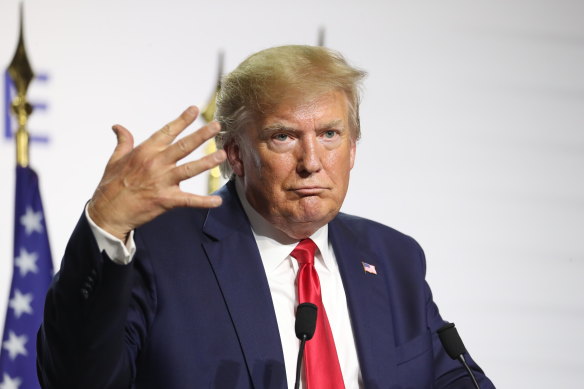Opinion
Donald Trump’s dangerous ideas have these ‘vigilantes’ worried
Stephen Bartholomeusz
Senior business columnistJoe Biden’s disastrous performance in last week’s US presidential debate is bringing the so-called “bond vigilantes” off the market’s sidelines that they have occupied for more than a decade and a half.
The increased likelihood that Donald Trump will regain the presidency – a prospect fuelled by Biden’s feeble display and by this week’s controversial US Supreme Court ruling on presidential immunity – has seen bond yields spike and the yield curve steepen, with the yields on longer-term bonds rising more than those at the short end of the curve.
The yield on two-year treasuries has only edged up from 4.71 per cent to 4.74 per cent, but the yield on 10-year bonds has jumped from 4.29 per cent ahead of the debate to 4.43 per cent, having touched 4.46 per cent on Monday.
A steepening yield curve indicates that bond investors anticipate higher inflation and higher interest rates in the future.
Before the debate, after the lowest core inflation price last week since March 2021, the markets were pricing in an outlook of falling inflation and two rate cuts from the Federal Reserve this year and more in 2025. Now they are just beginning to price in an expectation that, if Trump wins, inflation and interest rates will rise.
The term “bond vigilantes” was coined in 1983 by a young economist, Ed Yardeni, against a backdrop of rising US deficits, debt and inflation. He warned that if the fiscal and monetary authorities didn’t show more discipline bond investors would impose it on them by dumping US bonds, causing yields to surge.
Those “vigilantes” have been on the sidelines for most of the period since the global financial crisis even as, since Trump’s first term and through Biden’s, US deficits and debt have exploded.
Before Trump’s first term, the US budget deficit was about $US439 billion ($658 billion) and government debt was just over $US19.5 trillion.
Today the deficit is around $US2 trillion and debt $US34.7 trillion, with Trump adding about $US7.8 trillion of net debt and Biden about $US7 trillion so far. That’s resulted in an unprecedented amount of debt – a volume that continues to grow – having to be absorbed by bond market investors.
Both presidential candidates have proven to be profligate, so why would the vigilantes be stirring now?
Trump’s policies, if implemented, would be disruptive and potentially quite damaging to the US (and global) economy.
It’s not just because Trump showed a complete disregard for fiscal discipline his first time around but that he has a set of policies for a second term that would have far more impact on deficits, debt, inflation and the volume of bond issuance than that of that first term.
The core of his agenda relates to tax cuts, tariffs and immigration.
The largest element of his first term spending was the $US1.9 trillion package of tax cuts, primarily for companies and the wealthy. Those expire next year unless they’re extended.
Not only does Trump want to extend them, at a cost over the next decade that the Congressional Budget Office estimates at $US4.5 trillion, but he’s also flagged new and deeper cuts to personal and corporate taxes.
There’s been a lot of focus on Trump’s trade policies and his plan to impose a universal baseline tariff on all imports, with a 60 per cent tariff on all imports from China.
The cost of that to the US consumers who will actually pay for the tariffs through higher prices has been estimated at between $US1700 and $US2350 a year for the average middle-income US household, with the impact falling disproportionately on low-income households, which would see their income reduced by about 3.5 per cent.
The US Tax Foundation has estimated the new tariffs would raise more than $US524 billion of revenue – in effect they’d be a more than half-a-trillion-dollar new consumption tax – and shrink US GDP by at least 0.8 per cent.
Trump’s immigration policies, apart from stopping the flow of illegal migrants, envisage the mass detention and deportation of undocumented immigrants – he’s nominated between 15 and 20 million of them.

Donald Trump’s proposed policies have bond vigilantes worried.Credit: AP
Former Australian Reserve Bank economist Warwick McKibbin has argued that Trump’s policy would materially reduce the supply of low-cost labour in the US mining, agriculture, services and manufacturing industries.
His modelling has projected that US real GDP would be reduced by between 2.1 per cent (if 1.3 million migrants were deported) and 12 per cent (if 7.5 million, or half the lower end of Trump’s target range, were deported) and said both scenarios would ignite “serious” inflation.
When the impact on deficits, debt and tax on US inflation of those core policies are combined, you can understand why the bond vigilantes are starting to become restless.
There’s an additional layer to their agitation. Trump is no admirer of the Fed or its chairman Jerome Powell. He wanted to get rid of Powell during his last term and tried to stack the Fed with his own (quite peculiar) nominees but failed.
His advisers are known to have been working on schemes to either gut the Fed or bring it under the White House’s influence or even control, with the Fed obliged to consult and take account of the president’s views on interest rate moves.
An independent Fed would respond to a new outbreak of inflation by raising the US interest rate to whatever level was required to bring it under control. If Trump’s team was able to get any level of control over the central bank, inflation would be higher – potentially, given the nature of Trump’s agenda, far higher – than it would otherwise be.
Trump’s policies, if implemented, would be disruptive and potentially quite damaging to the US (and global) economy.

Credit: Matt Golding
Left unchecked by the Fed, inflation could reignite while the economy stalls or shrinks, which is why former US Treasury secretary, Larry Summers, has said the policies are “a prescription for the mother of all stagflations,” or an economy with high inflation, low (if any) growth and high unemployment.
It is little wonder that the bond vigilantes think they might have to take matters into their own hands if Trump prevails in November and proceeds to try to implement his key policies.
If the Fed isn’t willing or able to drive up interest rates in the event of a new outbreak of inflation they have demonstrated in the past that they are more than capable of doing that themselves, even if they have to drive the economy into the ground to impose their will.
The Business Briefing newsletter delivers major stories, exclusive coverage and expert opinion. Sign up to get it every weekday morning.